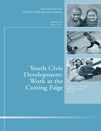Critical consciousness: Current status and future directions
Abstract
In this chapter, the authors consider Paulo Freire's construct of critical consciousness (CC) and why it deserves more attention in research and discourse on youth political and civic development. His approach to education and similar ideas by other scholars of liberation aims to foster a critical analysis of society—and one's status within it—using egalitarian, empowering, and interactive methods. The aim is social change as well as learning, which makes these ideas especially relevant to the structural injustice faced by marginalized youth. From their review of these ideas, the authors derive three core CC components: critical reflection, political efficacy, and critical action. They highlight promising research related to these constructs and innovative applied work including youth action-research methodology. Their conclusion offers ideas for closing some of the critical gaps in CC theory and research. © 2011 Wiley Periodicals, Inc.
REFERENCES
- Campbell, C., & MacPhail, C. (2002). Peer education, gender and the development of critical consciousness: Participatory HIV prevention by South African youth. Social Science and Medicine, 55(2), 331–345. doi:10.1016/S0277-9536(01)00289-1
- Carlson, E. D., Engbretson, J., & Chamberlain, R. M. (2006). Photovoice as a social process of critical consciousness. Qualitative Health Research, 16(6), 836–852. doi:10.1177/1049732306287525
- Corning, A. F., & Myers, D. J. (2002). Individual orientation toward engagement in social action. Political Psychology, 23(4), 703–729. doi:10.1111/0162-895X.00304
- Diemer, M. A., & Blustein, D. L. (2006). Critical consciousness and career development among urban youth. Journal of Vocational Behavior, 68(2), 220–232. doi:10.1016/j.jvb.2005.07.001
- Diemer, M. A., Kauffman, A., Koenig, N., Trahan, E., & Hsieh, C. (2006). Challenging racism, sexism, and social injustice: Support for urban adolescents' critical consciousness development. Cultural Diversity and Ethnic Minority Psychology, 12(3), 444–460.
- Diemer, M. A. & Li, C. (in press). Critical consciousness and political engagement among marginalized youth. Child Development.
- Flanagan, C. A., Syvertsen, A. K., Gill, S., Gallay, L. S., & Cumsille, P. (2009). Ethnic awareness, prejudice, and civic commitments in four ethnic groups of American adolescents. Journal of Youth and Adolescence, 38(4), 500–518. doi:10.1007/s10964-009-9394-z
- Freire, P. (1973). Education for critical consciousness. New York, NY: Seabury.
-
Ginwright, S., & James, T. (2002). From assets to agents of change: Social justice, organizing, and youth development. In B. Kirshner, J. L. O'Donoghue, & M. McLaughlin (Eds.), Youth participation: Improving institutions and communities. New Directions for Youth Development, 2002(96), 27–46. doi:10.1002/yd.25
10.1002/yd.25 Google Scholar
- Guessous, O. (2004). The sociopolitical development of community and labor organizers of color: A qualitative study (Unpublished master's thesis). Georgia State University, Atlanta.
- Kieffer, C. H. (1984). Citizen empowerment: A developmental perspective. Prevention in Human Services, 3, 9–36.
- Martín-Baró, I. (1994). Writings for a Liberation Psychology. Cambridge, MA: Harvard University Press.
-
Montero, M. (2009). Methods for liberation: Critical consciousness in action. In M. Montero & C. Sonn (Eds.), Psychology of liberation: Theory and applications (pp. 73–92). New York, NY: Springer.
10.1007/978-0-387-85784-8_4 Google Scholar
- Montero, M., & Sonn, C. (Eds.). (2009). Psychology of liberation: Theory and applications. New York, NY: Springer.
- Morrell, M. E. (2003). Survey and experimental evidence for a reliable and valid measure of internal political efficacy. Public Opinion Quarterly, 67, 589–602.
- Neville, H. A., Coleman, M. N., Falconer, J. W., & Holmes, D. (2005). Color-blind racial ideology and psychological false consciousness among African Americans. Journal of Black Psychology, 31(1), 27–45. doi:10.1177/0095798404268287
- Pancer, S. M., Pratt, M., Hunsberger, B., & Alisat, S. (2007). Community and political involvement in adolescence: What distinguishes the activists from the uninvolved? Journal of Community Psychology, 35, 741–759. doi:10.1002/jcop.20176
-
Peterson, N. A., Hamme, C. L., & Speer, P. W. (2002). Cognitive empowerment of African Americans and Caucasians: Differences in understandings of power, political functioning, and shaping ideology. Journal of Black Studies, 32(3), 332–347. doi:10.1177/002193470203200304
10.1177/002193470203200304 Google Scholar
- Pratto, F., Sidanius, J., Stallworth, L. M., & Malle, B. F. (1994). Social dominance orientation: A personality variable predicting social and political attitudes. Journal of Personality and Social Psychology, 67(4), 741–763.
-
Sellers, R. M., Chavous, T. M., & Cooke, D. Y. (1998). Racial ideology and racial centrality as predictors of African American college students' academic performance. Journal of Black Psychology, 24(1), 8–27. doi:10.1177/00957984980241002
10.1177/00957984980241002 Google Scholar
-
Stepick, A., & Stepick, C. (2002). Becoming American, constructing ethnicity: Immigrant youth and civic engagement. Applied Developmental Science, 6(4), 246–257. doi: 10.1207/S1532480XADS0604_12
10.1207/S1532480XADS0604_12 Google Scholar
- Stewart, S., Riecken, T., Scott, T., Tanaka, M., & Riecken, J. (2008). Expanding health literacy: Indigenous youth creating videos. Journal of Health Psychology, 13, 180–189. doi: 10.1177/1359105307086709
- Watts, R. (2010). Learning principles for political and civic education from young activists. Chicago, IL: The Spencer Foundation.
- Watts, R. J., & Flanagan, C. (2007). Pushing the envelope on youth civic engagement: A developmental and liberation psychology perspective. Journal of Community Psychology, 35(6), 779–792. doi:10.1002/jcop.20178
- Watts, R. J., Griffith, D. M., & Abdul-Adil, J. (1999). Sociopolitical development as an antidote for oppression—theory and action. American Journal of Community Psychology, 27(2), 255–271. doi:10.1023/A:1022839818873
- Westheimer, J., & Kahne, J. (2003). Teaching democracy: What schools need to do. Phi Delta Kappan, 85(1), 34–40, 57–66.
- Zimmerman, M. (2000). Empowerment theory: Psychological, organizational, and community levels of analysis. In J. Rappaport & E. Seidman (Eds.), Handbook of community psychology (pp. 43–63). New York, NY: Kluwer.
- Zimmerman, M., & Rappaport, J. (1988). Citizen participation, perceived control, and psychological empowerment. American Journal of Community Psychology, 16, 725–750. doi:10.1007/BF00930023
- Zimmerman, M. A., & Zahniser, J. H. (1991). Refinements of sphere-specific measures of perceived control: Development of a sociopolitical control scale. Journal of Community Psychology, 19, 189–204. doi:10.1002/1520-6629(199104)19:2?189::AID-JCOP2290190210?3.0.CO;2–6




